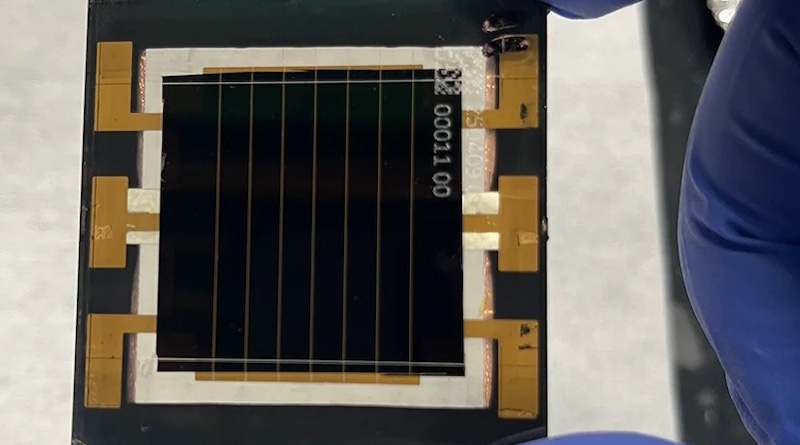Last Updated on: 10th July 2025, 02:13 am
A collaborative effort between NREL and CubicPV has yielded a perovskite minimodule that belongs in the record books.
The 24.0% certified efficiency marks the first time a U.S. effort has set a record in the perovskite minimodule category.
The researchers at NREL and at CubicPV, a company based in the Boston area, made the minimodule consisting of multiple interconnected cells, with several steps in the fabrication sequence done at each location.
Kai Zhu, a senior scientist in NREL’s Chemistry and Nanoscience Center has previously collaborated with CubicPV. Zhu said the complementary expertise of the two organizations is a testament not only to technical excellence, but to the accelerated impact of combining complementary strengths.
“It’s really the strength from both parties that creates the environment for record setting,” he said. “Both teams can achieve great results —but collaboration amplifies our impact and sets new device benchmarks.” CubicPV’s focus is on tandem solar devices, using perovskites on top of silicon to make a solar panel that captures more photons and continues to lower the cost of energy, while NREL’s focus is on advancing manufacturing, durability, and efficiency of perovskite-enabled tandems. The collaboration amplifies each partner’s strengths.
Unlike silicon, perovskites are created by using a low-temperature (less than 200°C) ink-based printing or vacuum coating process with primarily earth-abundant materials. The technology has proven to be efficient at small scale, and work to improve durability and efficiency on larger-area devices, which are prerequisite for commercial adoption, continues. Perovskites hold the promise of diversifying the supply chain and increasing domestic production of solar photovoltaic modules.
Adam Lorenz, chief technology officer of CubicPV, said future efforts will focus on demonstrating durable performance outdoors and producing larger area perovskite modules. “We are committed to leveraging U.S. technical leadership and collaborating with the top researchers in the world to drive cutting-edge perovskite science toward scalable, commercially viable, and durable products,” he said.
The previous record for a perovskite minimodule, published in May 2025, was 23.9%. The solar cell efficiency tables are published twice a year in the journal Progress in Photovoltaics. The next iteration will appear near year’s end, which gives NREL and CubicPV time to surpass their current record.
The U.S. Department of Energy’s Solar Energy Technologies Office funded the research.
Article from NREL. By Wayne Hicks
Sign up for CleanTechnica’s Weekly Substack for Zach and Scott’s in-depth analyses and high level summaries, sign up for our daily newsletter, and follow us on Google News!
Whether you have solar power or not, please complete our latest solar power survey.
Have a tip for CleanTechnica? Want to advertise? Want to suggest a guest for our CleanTech Talk podcast? Contact us here.
Sign up for our daily newsletter for 15 new cleantech stories a day. Or sign up for our weekly one on top stories of the week if daily is too frequent.
CleanTechnica uses affiliate links. See our policy here.
CleanTechnica’s Comment Policy

